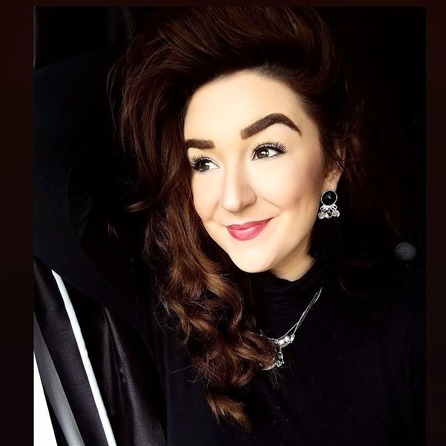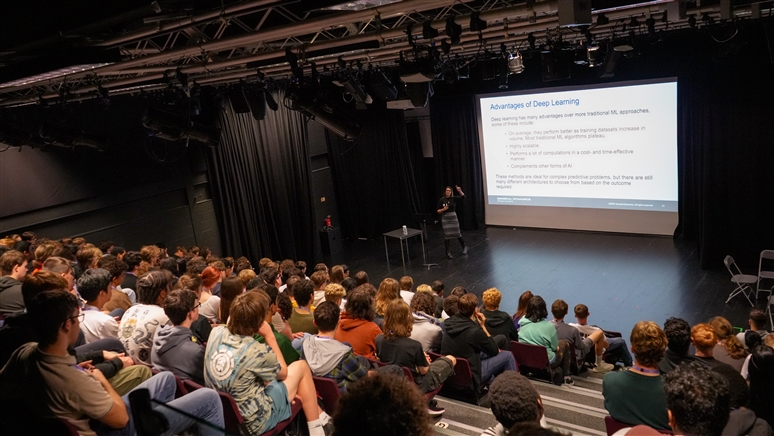Continuing our blog series 'A Day in the Life of an Engineer', we caught up with Kirsten McCormick MSc(Hons) MIET to find out more about her day as a Systems Engineer and AI Lead for General Dynamics Mission Systems (GDMS)
Like many different jobs and roles you find in an organisation, working with Artificial Intelligence (AI) and Machine Learning (ML) can differ hugely depending on the industry, the techniques, the use cases, and even the company. So, though this is my life, day by day it changes, and I bet it will share both similarities and huge differences between others working in this technology area.
Who I am and what I do
 So, as an introduction, my name is Kirsten McCormick, I am a Senior Systems Engineer and AI Lead in General Dynamics Mission Systems (GDMS) Hastings. I have been in this company for around 5 years, and I love it. GDMS is part of the bigger General Dynamics corporation that has technology everywhere, from space all the way to subsea and everything in between. Mission Systems sits within the international branch and connects users and protects their information, where I mainly work within the Avioniq’s domain, providing key systems to platforms such as the Eurofighter Typhoon and the Leonardo Helicopters Wildcat.
So, as an introduction, my name is Kirsten McCormick, I am a Senior Systems Engineer and AI Lead in General Dynamics Mission Systems (GDMS) Hastings. I have been in this company for around 5 years, and I love it. GDMS is part of the bigger General Dynamics corporation that has technology everywhere, from space all the way to subsea and everything in between. Mission Systems sits within the international branch and connects users and protects their information, where I mainly work within the Avioniq’s domain, providing key systems to platforms such as the Eurofighter Typhoon and the Leonardo Helicopters Wildcat.
Everyday I start work at 07:00am and work through till 16:00pm, for me my brain can handle complex things early so I prefer to shift my day so I can start early and finish early. Typically, the first thing I tackle is emails, any emails that are outstanding or priority get answered, that way I can warm up to work with a good cup of coffee.
Every day looks like this
My daily responsibilities vary, as I am also a Systems engineer, which looks quite different from my AI responsibilities! But when I am in my AI role, there are still many different things that I do. When I am running the technical AI part of a development program, I often get up to date with progress and metrics of the models, sit down with the team to discuss the issues or successes and understand what is going right or wrong. I also help with writing the technologies, such as Deep Neural Networks, and train up any team members that may need it. Now AI programs run well in an iterative approach, where complexity increases with each iteration of development. This means that whenever we are developing the models, we are also looking to figure out what complexities can be added. I find it very hands on work, but very rewarding and you are continuously learning things such as new type of techniques, and intricacies of implementing AI.
When I am not actively developing, or helping to develop, AI there are still many different things that I do. These usually fall under one of the sub headers below.
- Strategy- Identifying key USP for the company where AI would make sense to be used. Also bringing in other initiatives from the broader GD so that we are not working in siloes.
- Policy- Understanding how we should be using AI, and how we should not be using AI. For example, using things such as ChatGPT for work material may be leaking IP.
- Broader AI Implications- Understanding the safety, ethics, trust, and other implications of using AI with the Defense and Aerospace sector. I look at things such as the EU AI Act and Pact to understand how we align to these within development.
- Communication – Communicating internally what AI is, how we can be using it and understanding other business unit’s needs.
- Use Case exploration- Exploring how to identify use cases within the company.
Speaking to wider audiences
In addition to these responsibilities, I am also the Chair of the IET AI Technical Network. This is a worldwide technical network that is made up of AI experts that support the growth of AI by promoting and challenging conventional approaches in businesses and society. We also reach out to the community and give lectures, webinars, and events to help people understand AI on a variety of levels. This keeps me busy and allows me to express my passion of AI to a wider audience.

Throughout the past 5 years I am so grateful of what I have been able to achieve. One of my best achievements was being asked to present two papers at the SPIE Defense and Sensing conference in Orlando last year. This was an incredible opportunity for me to present in front of an international audience at the leading global event featuring mission-critical sensing innovations acquired and deployed within public, security, and government applications. Alongside the technical AI achievements, it was an honour to have been named a Finalist in the 2022 Top 50 Women in Engineering: Inventors and Innovators for one of the AI applications that was developed. In addition, I was also truly grateful to be the chair of the IET AI TN, as this is something I am truly passionate about and I love giving back to the community and demystifying AI with an incredible team of experts.
Finally…
So, to wrap this up, my days are filled with so much, and I love the variety of things that I get to work on. Whilst writing this I really have realised how much I truly love everything I do, and I am utterly grateful to my company for supporting me and allowing me to be a part of their AI journey. But what I love most (aside from the actual technology itself as it is just awesome!) is being part of the AI wave and bringing in new technology and initiatives into the company to help future business. Overall, I just love making a difference.
Want to share a day in your working life with the EngX Community? Get in touch with the Editorial team at community-online@ietengx.org
#lifeofanengineer